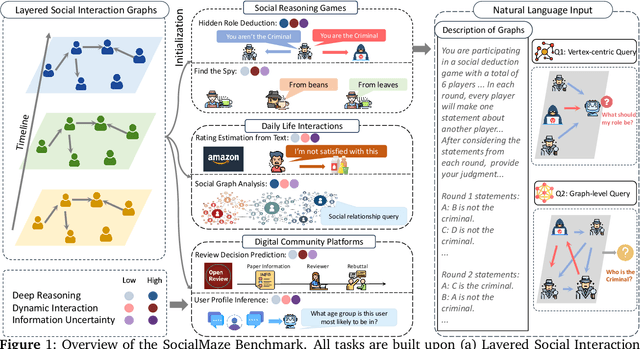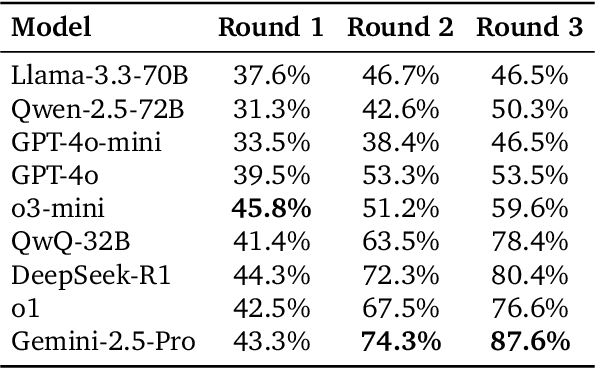Yue Zhao
Ben
Beyond the high score: Prosocial ability profiles of multi-agent populations
Sep 17, 2025Abstract:The development and evaluation of social capabilities in AI agents require complex environments where competitive and cooperative behaviours naturally emerge. While game-theoretic properties can explain why certain teams or agent populations outperform others, more abstract behaviours, such as convention following, are harder to control in training and evaluation settings. The Melting Pot contest is a social AI evaluation suite designed to assess the cooperation capabilities of AI systems. In this paper, we apply a Bayesian approach known as Measurement Layouts to infer the capability profiles of multi-agent systems in the Melting Pot contest. We show that these capability profiles not only predict future performance within the Melting Pot suite but also reveal the underlying prosocial abilities of agents. Our analysis indicates that while higher prosocial capabilities sometimes correlate with better performance, this is not a universal trend-some lower-scoring agents exhibit stronger cooperation abilities. Furthermore, we find that top-performing contest submissions are more likely to achieve high scores in scenarios where prosocial capabilities are not required. These findings, together with reports that the contest winner used a hard-coded solution tailored to specific environments, suggest that at least one top-performing team may have optimised for conditions where cooperation was not necessary, potentially exploiting limitations in the evaluation framework. We provide recommendations for improving the annotation of cooperation demands and propose future research directions to account for biases introduced by different testing environments. Our results demonstrate that Measurement Layouts offer both strong predictive accuracy and actionable insights, contributing to a more transparent and generalisable approach to evaluating AI systems in complex social settings.
Score Matching on Large Geometric Graphs for Cosmology Generation
Aug 23, 2025Abstract:Generative models are a promising tool to produce cosmological simulations but face significant challenges in scalability, physical consistency, and adherence to domain symmetries, limiting their utility as alternatives to $N$-body simulations. To address these limitations, we introduce a score-based generative model with an equivariant graph neural network that simulates gravitational clustering of galaxies across cosmologies starting from an informed prior, respects periodic boundaries, and scales to full galaxy counts in simulations. A novel topology-aware noise schedule, crucial for large geometric graphs, is introduced. The proposed equivariant score-based model successfully generates full-scale cosmological point clouds of up to 600,000 halos, respects periodicity and a uniform prior, and outperforms existing diffusion models in capturing clustering statistics while offering significant computational advantages. This work advances cosmology by introducing a generative model designed to closely resemble the underlying gravitational clustering of structure formation, moving closer to physically realistic and efficient simulators for the evolution of large-scale structures in the universe.
Dream to Chat: Model-based Reinforcement Learning on Dialogues with User Belief Modeling
Aug 23, 2025Abstract:World models have been widely utilized in robotics, gaming, and auto-driving. However, their applications on natural language tasks are relatively limited. In this paper, we construct the dialogue world model, which could predict the user's emotion, sentiment, and intention, and future utterances. By defining a POMDP, we argue emotion, sentiment and intention can be modeled as the user belief and solved by maximizing the information bottleneck. By this user belief modeling, we apply the model-based reinforcement learning framework to the dialogue system, and propose a framework called DreamCUB. Experiments show that the pretrained dialogue world model can achieve state-of-the-art performances on emotion classification and sentiment identification, while dialogue quality is also enhanced by joint training of the policy, critic and dialogue world model. Further analysis shows that this manner holds a reasonable exploration-exploitation balance and also transfers well to out-of-domain scenarios such as empathetic dialogues.
A Systematic Survey of Model Extraction Attacks and Defenses: State-of-the-Art and Perspectives
Aug 20, 2025Abstract:Machine learning (ML) models have significantly grown in complexity and utility, driving advances across multiple domains. However, substantial computational resources and specialized expertise have historically restricted their wide adoption. Machine-Learning-as-a-Service (MLaaS) platforms have addressed these barriers by providing scalable, convenient, and affordable access to sophisticated ML models through user-friendly APIs. While this accessibility promotes widespread use of advanced ML capabilities, it also introduces vulnerabilities exploited through Model Extraction Attacks (MEAs). Recent studies have demonstrated that adversaries can systematically replicate a target model's functionality by interacting with publicly exposed interfaces, posing threats to intellectual property, privacy, and system security. In this paper, we offer a comprehensive survey of MEAs and corresponding defense strategies. We propose a novel taxonomy that classifies MEAs according to attack mechanisms, defense approaches, and computing environments. Our analysis covers various attack techniques, evaluates their effectiveness, and highlights challenges faced by existing defenses, particularly the critical trade-off between preserving model utility and ensuring security. We further assess MEAs within different computing paradigms and discuss their technical, ethical, legal, and societal implications, along with promising directions for future research. This systematic survey aims to serve as a valuable reference for researchers, practitioners, and policymakers engaged in AI security and privacy. Additionally, we maintain an online repository continuously updated with related literature at https://github.com/kzhao5/ModelExtractionPapers.
PrivacyXray: Detecting Privacy Breaches in LLMs through Semantic Consistency and Probability Certainty
Jun 24, 2025Abstract:Large Language Models (LLMs) are widely used in sensitive domains, including healthcare, finance, and legal services, raising concerns about potential private information leaks during inference. Privacy extraction attacks, such as jailbreaking, expose vulnerabilities in LLMs by crafting inputs that force the models to output sensitive information. However, these attacks cannot verify whether the extracted private information is accurate, as no public datasets exist for cross-validation, leaving a critical gap in private information detection during inference. To address this, we propose PrivacyXray, a novel framework detecting privacy breaches by analyzing LLM inner states. Our analysis reveals that LLMs exhibit higher semantic coherence and probabilistic certainty when generating correct private outputs. Based on this, PrivacyXray detects privacy breaches using four metrics: intra-layer and inter-layer semantic similarity, token-level and sentence-level probability distributions. PrivacyXray addresses critical challenges in private information detection by overcoming the lack of open-source private datasets and eliminating reliance on external data for validation. It achieves this through the synthesis of realistic private data and a detection mechanism based on the inner states of LLMs. Experiments show that PrivacyXray achieves consistent performance, with an average accuracy of 92.69% across five LLMs. Compared to state-of-the-art methods, PrivacyXray achieves significant improvements, with an average accuracy increase of 20.06%, highlighting its stability and practical utility in real-world applications.
NeuralPDR: Neural Differential Equations as surrogate models for Photodissociation Regions
Jun 17, 2025Abstract:Computational astrochemical models are essential for helping us interpret and understand the observations of different astrophysical environments. In the age of high-resolution telescopes such as JWST and ALMA, the substructure of many objects can be resolved, raising the need for astrochemical modeling at these smaller scales, meaning that the simulations of these objects need to include both the physics and chemistry to accurately model the observations. The computational cost of the simulations coupling both the three-dimensional hydrodynamics and chemistry is enormous, creating an opportunity for surrogate models that can effectively substitute the chemical solver. In this work we present surrogate models that can replace the original chemical code, namely Latent Augmented Neural Ordinary Differential Equations. We train these surrogate architectures on three datasets of increasing physical complexity, with the last dataset derived directly from a three-dimensional simulation of a molecular cloud using a Photodissociation Region (PDR) code, 3D-PDR. We show that these surrogate models can provide speedup and reproduce the original observable column density maps of the dataset. This enables the rapid inference of the chemistry (on the GPU), allowing for the faster statistical inference of observations or increasing the resolution in hydrodynamical simulations of astrophysical environments.
Language-Image Alignment with Fixed Text Encoders
Jun 04, 2025Abstract:Currently, the most dominant approach to establishing language-image alignment is to pre-train text and image encoders jointly through contrastive learning, such as CLIP and its variants. In this work, we question whether such a costly joint training is necessary. In particular, we investigate if a pre-trained fixed large language model (LLM) offers a good enough text encoder to guide visual representation learning. That is, we propose to learn Language-Image alignment with a Fixed Text encoder (LIFT) from an LLM by training only the image encoder. Somewhat surprisingly, through comprehensive benchmarking and ablation studies, we find that this much simplified framework LIFT is highly effective and it outperforms CLIP in most scenarios that involve compositional understanding and long captions, while achieving considerable gains in computational efficiency. Our work takes a first step towards systematically exploring how text embeddings from LLMs can guide visual learning and suggests an alternative design choice for learning language-aligned visual representations.
SocialMaze: A Benchmark for Evaluating Social Reasoning in Large Language Models
May 29, 2025



Abstract:Large language models (LLMs) are increasingly applied to socially grounded tasks, such as online community moderation, media content analysis, and social reasoning games. Success in these contexts depends on a model's social reasoning ability - the capacity to interpret social contexts, infer others' mental states, and assess the truthfulness of presented information. However, there is currently no systematic evaluation framework that comprehensively assesses the social reasoning capabilities of LLMs. Existing efforts often oversimplify real-world scenarios and consist of tasks that are too basic to challenge advanced models. To address this gap, we introduce SocialMaze, a new benchmark specifically designed to evaluate social reasoning. SocialMaze systematically incorporates three core challenges: deep reasoning, dynamic interaction, and information uncertainty. It provides six diverse tasks across three key settings: social reasoning games, daily-life interactions, and digital community platforms. Both automated and human validation are used to ensure data quality. Our evaluation reveals several key insights: models vary substantially in their ability to handle dynamic interactions and integrate temporally evolving information; models with strong chain-of-thought reasoning perform better on tasks requiring deeper inference beyond surface-level cues; and model reasoning degrades significantly under uncertainty. Furthermore, we show that targeted fine-tuning on curated reasoning examples can greatly improve model performance in complex social scenarios. The dataset is publicly available at: https://huggingface.co/datasets/MBZUAI/SocialMaze
Interactive Post-Training for Vision-Language-Action Models
May 22, 2025Abstract:We introduce RIPT-VLA, a simple and scalable reinforcement-learning-based interactive post-training paradigm that fine-tunes pretrained Vision-Language-Action (VLA) models using only sparse binary success rewards. Existing VLA training pipelines rely heavily on offline expert demonstration data and supervised imitation, limiting their ability to adapt to new tasks and environments under low-data regimes. RIPT-VLA addresses this by enabling interactive post-training with a stable policy optimization algorithm based on dynamic rollout sampling and leave-one-out advantage estimation. RIPT-VLA has the following characteristics. First, it applies to various VLA models, resulting in an improvement on the lightweight QueST model by 21.2%, and the 7B OpenVLA-OFT model to an unprecedented 97.5% success rate. Second, it is computationally efficient and data-efficient: with only one demonstration, RIPT-VLA enables an unworkable SFT model (4%) to succeed with a 97% success rate within 15 iterations. Furthermore, we demonstrate that the policy learned by RIPT-VLA generalizes across different tasks and scenarios and is robust to the initial state context. These results highlight RIPT-VLA as a practical and effective paradigm for post-training VLA models through minimal supervision.
A Personalized Conversational Benchmark: Towards Simulating Personalized Conversations
May 20, 2025Abstract:We present PersonaConvBench, a large-scale benchmark for evaluating personalized reasoning and generation in multi-turn conversations with large language models (LLMs). Unlike existing work that focuses on either personalization or conversational structure in isolation, PersonaConvBench integrates both, offering three core tasks: sentence classification, impact regression, and user-centric text generation across ten diverse Reddit-based domains. This design enables systematic analysis of how personalized conversational context shapes LLM outputs in realistic multi-user scenarios. We benchmark several commercial and open-source LLMs under a unified prompting setup and observe that incorporating personalized history yields substantial performance improvements, including a 198 percent relative gain over the best non-conversational baseline in sentiment classification. By releasing PersonaConvBench with evaluations and code, we aim to support research on LLMs that adapt to individual styles, track long-term context, and produce contextually rich, engaging responses.
 Add to Chrome
Add to Chrome Add to Firefox
Add to Firefox Add to Edge
Add to Edge